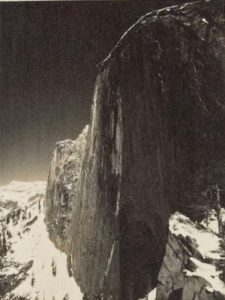
![]() In 1927, Ansel Adams was hard at work on photographs for his Parmelian Print series. He was determined to make an image of Half Dome, a massive granite formation rising half a mile from the valley floor. He wanted to photograph it from a rock slab nicknamed “The Diving Board,” which hung out 3500 feet above the valley and offered an unsurpassed view of Half Dome’s huge Western face.
In 1927, Ansel Adams was hard at work on photographs for his Parmelian Print series. He was determined to make an image of Half Dome, a massive granite formation rising half a mile from the valley floor. He wanted to photograph it from a rock slab nicknamed “The Diving Board,” which hung out 3500 feet above the valley and offered an unsurpassed view of Half Dome’s huge Western face.
With four friends on an April day, Adams began the rigorous hours-long hike—he called it a “scramble”—to the Diving Board, making their way across slippery trails. The rest of the group relied on their hiking shoes for traction. Adams wore black basketball sneakers.[footnote]Mary Street Alinder, Ansel Adams, A Biography (New York: Henry Holt and Company, 1996), p. 57.[/footnote] He carried a 40-pound backpack with his bulky 6 ½ x 8 /12 Korona view camera, several lenses and filters, and a dozen glass negatives. He strapped a heavy wooden tripod to his backpack. He was 25 years old, six feet tall, and weighed only 125 pounds.[footnote]Ansel Adams, Examples, The Making of 40 Photographs (Boston: Little, Brown and Company, 1983), p. 3.[/footnote]
Composition was done on a ground glass background, with the scene viewed upside down. He set up his camera and composed the image, using a yellow filter to slightly darken the sky. The shadow effect seemed right, so he made the exposure.
He later recalled, “As I replaced the slide, I began to think about how the print was to appear, and if it would transmit any of the feeling of the monumental shape before me in terms of its expressive-emotional quality. I began to see in my mind’s eye the finished print I desired: the brooding cliff with a dark sky and the sharp rendition of distant, snowy Tenaya Peak.” He realized that he needed a deep red filter to darken the sky to create the emotional effect he wanted. He exposed his last plate. That night when he developed the plate, he realized he had succeeded. As he wrote, “I had achieved my first true visualization! I had been able to realize a desired image: not the way the subject appeared in reality but how it felt to me and how it must appear in the finished print. The sky had actually been a light, slightly hazy blue and the sunlit areas of Half Dome were moderately dark gray in value. The red filter dramatically darkened the sky and the shadows on the great cliff. Luckily I had with me the filter that made my visualized image possible.”[footnote]Ansel Adams, Ansel Adams, An Autobiography (Boston: Little, Brown and Company, 1985), p. 76.[/footnote]
Today Monolith is considered Adams’ first masterpiece. He was able to achieve it through visualization of the finished print, but also through manipulation of the observed scene. The sky wasn’t dark – it was a nice day. But the mood he wanted to create to match his personal response to the massive rock formation was an emotionally dark one, so he altered the sky accordingly. Now, we can do this with Photoshop, although some people would chastise a photographer for tinkering with reality like this. But for Adams, this manipulation enabled him to create a photograph that went beyond a record to become a statement. People sometimes wonder what Adams would have thought of Photoshop. He probably would would have loved it. As he put it, “the photographer visualizes his conception of the subject as presented in the final print. He achieves the expression of his visualization through his technique—aesthetic, intellectual, and mechanical.”[footnote]Ansel Adams, Ansel Adams, An Autobiography (Boston: Little, Brown and Company, 1985), p. 77-78.[/footnote]